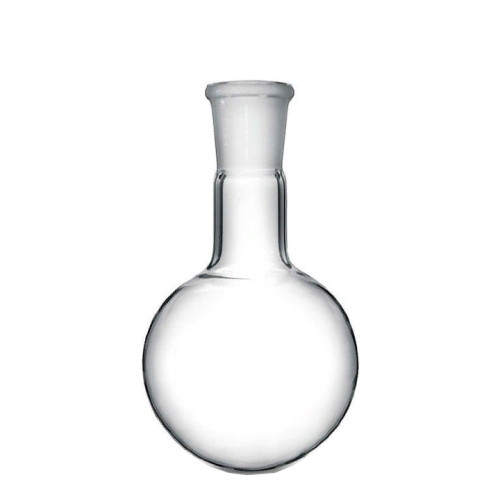Round Bottom Flask with Ground Joint
Technical Specifications
Material: Borosilicate Glass
Volume Range: 50 mL to 5000 mL
Joint Size: 24/40, 19/22, and other standard sizes
Temperature Resistance: Up to 500°C
Chemical Resistance: Resistant to acids, alkalis, and organic solvents
Wall Thickness: 1.5 mm to 2.5 mm, depending on size
Weight: Varies with size, typically between 50g to 1kg
available soon
Round Bottom Flask with Ground Joint
Last month I watched a synthesis postdoc lose 22 grams of purified intermediate because she grabbed the wrong joint size. Her adapter didn't seat properly at the taper, vacuum failed at 12 torr, and the product oxidized before she could salvage it. Ground joint round bottom flasks aren't optional when you're working under reduced pressure—they're what separates reproducible yields from explaining to your PI why you need three more weeks.
Borosilicate 3.3 glass handles thermal shock from liquid nitrogen quenching straight into 180°C oil baths without cracking. The spherical geometry distributes vacuum pressure uniformly across the entire surface, eliminating the stress concentration points that plague flat designs. When you're pulling vacuum down to 0.01 torr for high-boiling compounds, that curved profile becomes critical—atmospheric pressure exerts over 10 tons of force on a 2L flask, and sharp corners turn into crack initiation sites.
Selecting the Correct Ground Joint Size to Prevent Synthesis Product Loss
Frosted glass surfaces create thousands of microscopic contact points that form airtight seals when properly mated. A thin layer of vacuum grease—petroleum jelly applied sparingly with your finger—prevents seizing during extended heating while maintaining seal integrity. Joint sizing follows a two-number designation where the first indicates outer diameter and the second shows insertion depth in millimeters.
Mixing joint sizes guarantees failure. I've seen research groups waste entire afternoons hunting for adapters because someone ordered 19/22 flasks for a 24/40 setup. Unlike a Conical flask with ground section 14/23 that locks you into one specific size, standardizing on 24/40 across your entire glassware inventory means any condenser, adapter, or stopper connects without compatibility headaches.
Joint Size Matching for Secure Vacuum-Tight Connections
- 14/20 joints handle microscale work under 50mL where small bore doesn't restrict vapor flow
- 19/22 joints fit bench-scale synthesis between 50-250mL for routine organic prep
- 24/40 joints serve as the universal standard compatible with 90% of lab glassware configurations
- 29/42 joints support production volumes above 2L where wider openings prevent condensation backup
Joint inspection matters more than most techs realize. Hold each piece up to bright light and look for etching or fogging from alkaline solutions that destroy the smooth mating surface, star cracks radiating from the joint rim indicating imminent catastrophic failure, chips or rough spots that create leak paths no amount of grease can seal, and chemical residue buildup that prevents proper seating depth. Clean joints immediately after disassembly using acetone and lint-free wipes before residues bake on permanently.
Why Standardized Tapers Matter in Multi-Step Reactions
Multi-neck configurations transform simple flasks into complete reaction centers. Single-neck versions handle straightforward distillations and rotovap solvent removal—you'll cycle through dozens weekly during chromatography workups, evaporating fraction after fraction. Two-neck flasks accommodate thermometer adapters in the side joint while maintaining inert atmosphere through the main opening. Three-neck setups become synthetic workhorses with an addition funnel on one joint, reflux condenser on center neck, and thermometer or nitrogen inlet on the third.
Heat transfer efficiency jumps dramatically compared to a Flat-Bottom Flask with Joint because the entire liquid mass maintains contact with heated glass during rotation. Rotary evaporators spin these flasks at 60-120 RPM, spreading solvent into micrometer-thin films that evaporate 5-10 times faster than static pools. Pharmaceutical labs running kilogram-scale API purifications rely on this geometry to process batches in hours instead of days.
A Boiling Flask,round bottom without ground joints costs 40% less but eliminates your ability to connect vacuum adapters, condensers, or any modular components. That initial savings evaporates when you're stuck using inefficient heating methods and can't run vacuum distillations. When you need stable positioning on a stir plate without vacuum work, a Boiling Flask,flat bottom sits securely without cork rings, but you sacrifice the connection versatility that ground joints provide.
Avoiding Cross-Contamination Through Proper Joint Selection
- Match heating mantle size precisely to flask volume—a 500mL flask requires a 500mL mantle, not approximations with sand baths that create hotspots
- Position side joints at 20° angles from vertical on multi-neck flasks to prevent strain on connected adapters during thermal expansion
- Store flasks nested with protective foam between joints to prevent the cabinet-shuffling damage that chips rims
- Replace flasks immediately when joints show wear—the $80 replacement costs less than one ruined synthesis
Maximum working temperature reaches 500°C for short exposures and 230°C for continuous operation. Chemical resistance covers most organic solvents, mineral acids, and weak bases, though hydrofluoric acid and hot concentrated alkali attack the glass matrix. The coefficient of thermal expansion sits at 3.3 × 10⁻⁶ K⁻¹, which translates to minimal dimensional changes during the temperature cycling that shatters cheaper soda-lime glass.
For storage applications where you don't need modular connections, a Conical flask, narrow neck offers easier pouring and cleaning access, though it can't handle vacuum operations. Graduate students doing natural product isolation understand that ground joint compatibility across your entire glassware setup means you're never hunting for adapters when you're in the middle of a time-sensitive workup at 2 AM.
Leave a review about product
Sign up to our newsletter to get the latest news and updates about our products.

